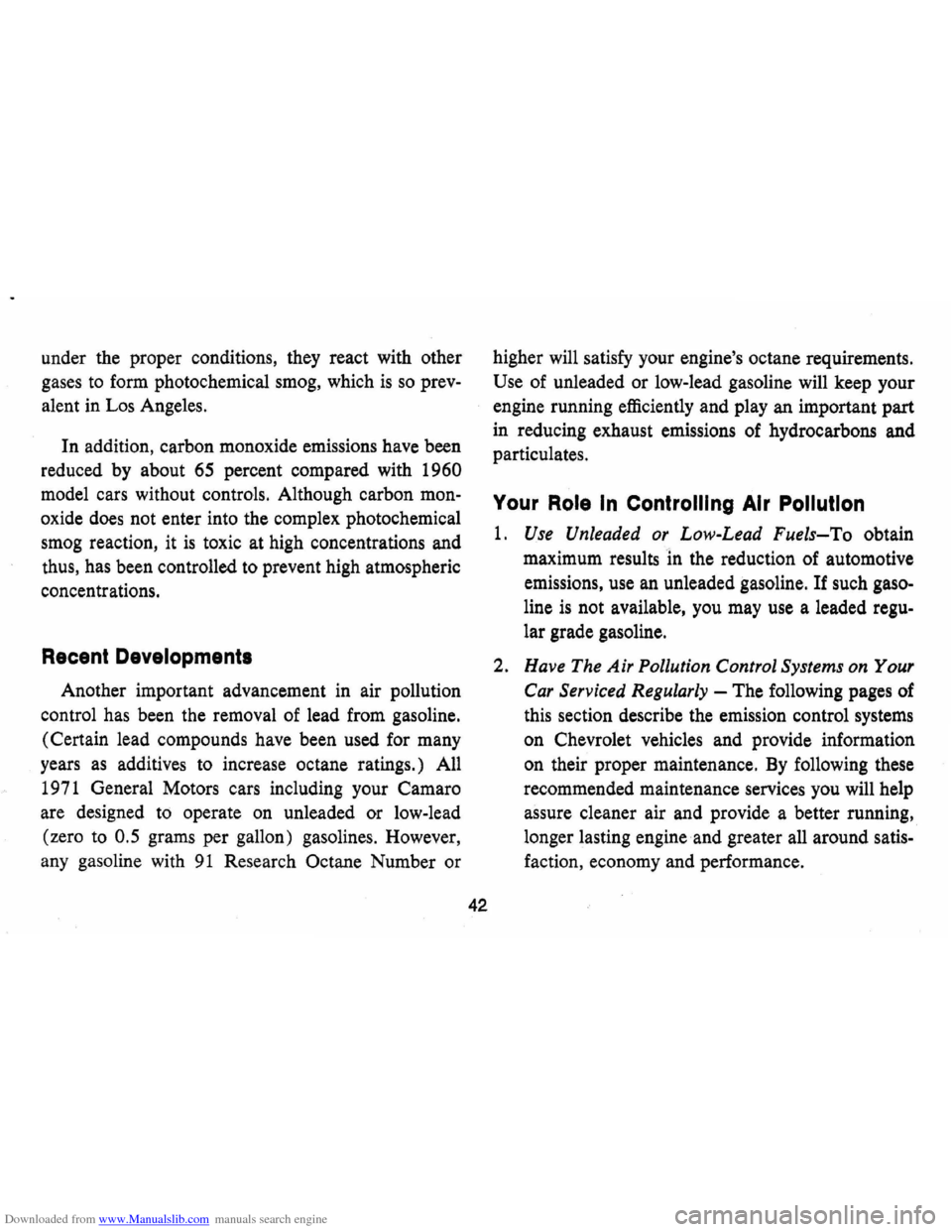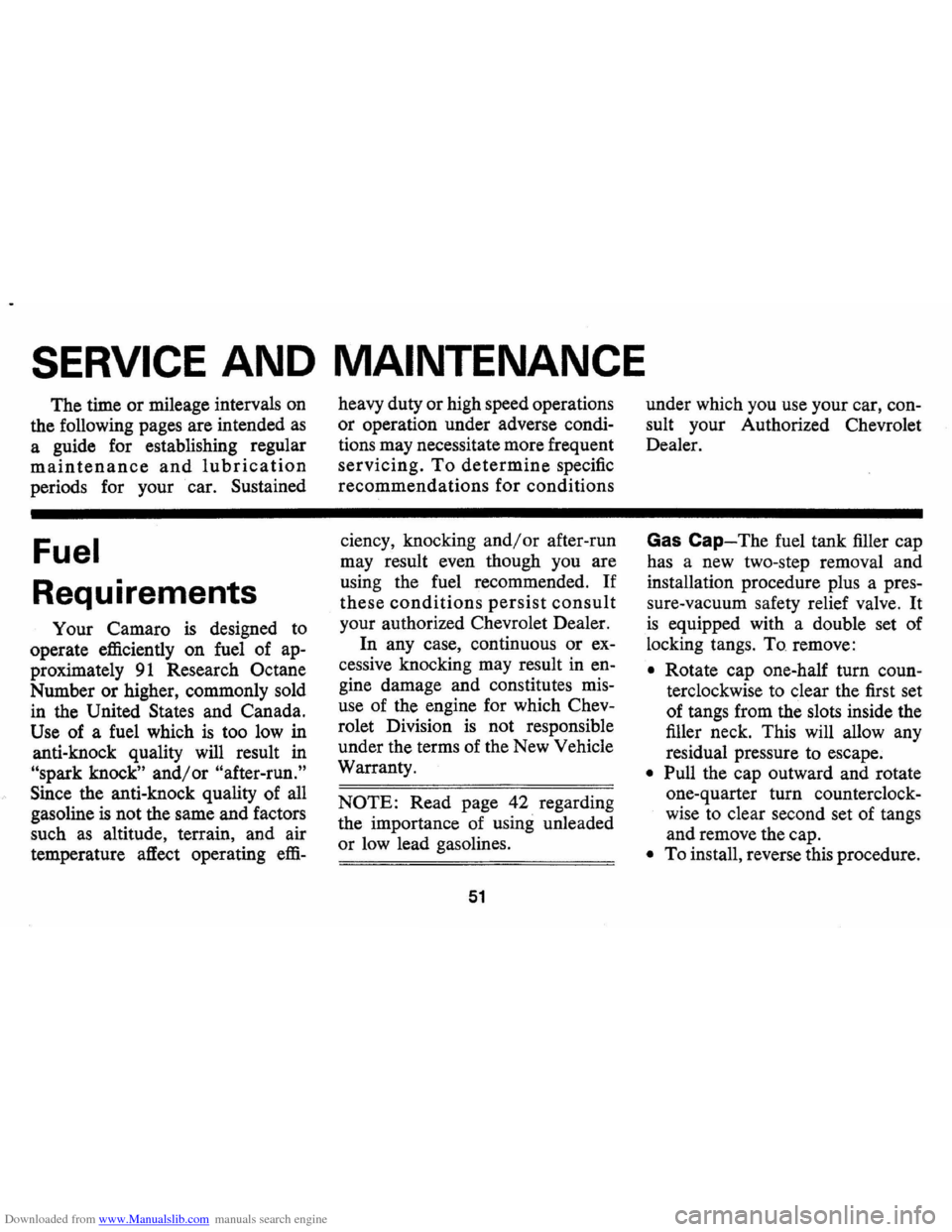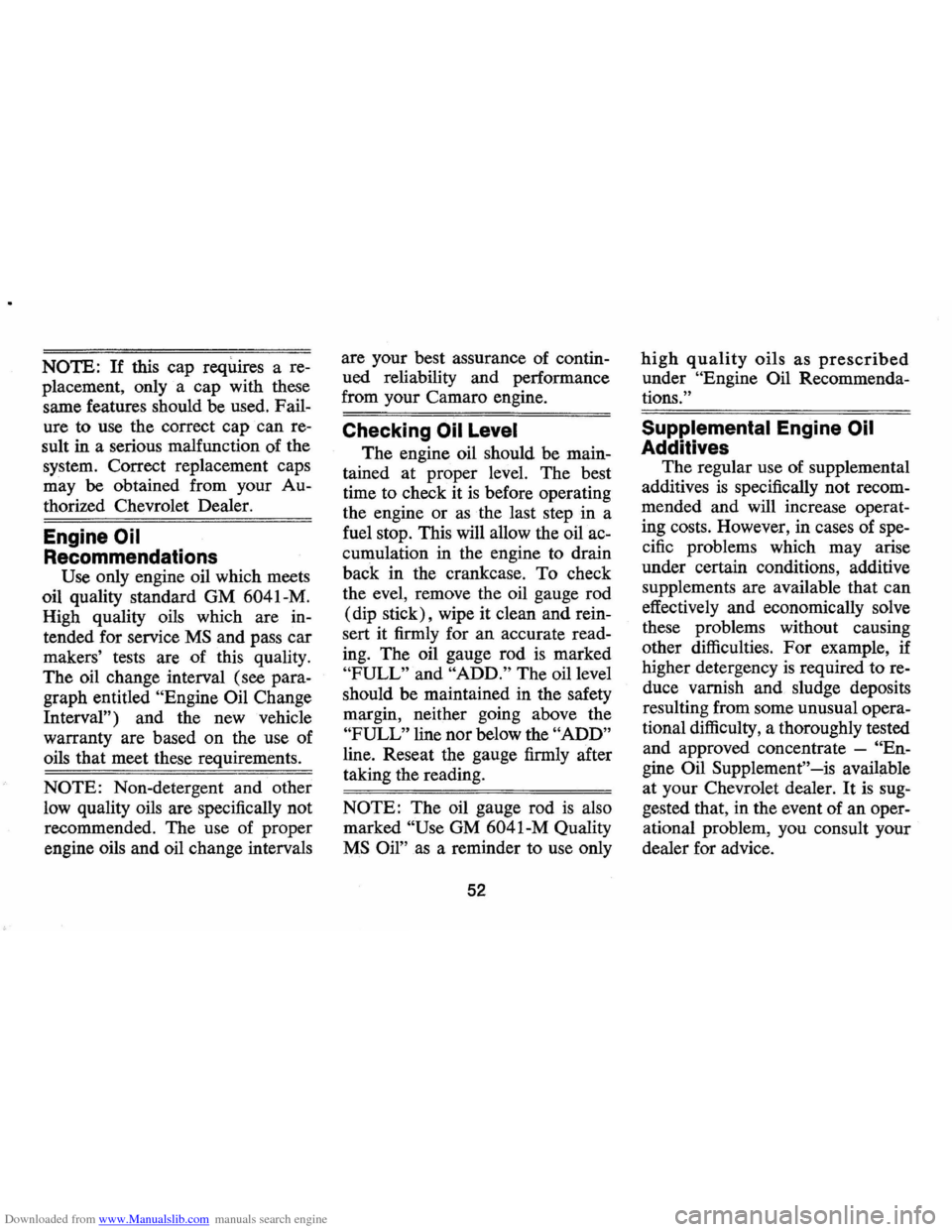1971 CHEVROLET CAMARO service
[x] Cancel search: servicePage 44 of 88

Downloaded from www.Manualslib.com manuals search engine WHAT YOU SHOULD KNOW ABOUT
AIR POLLUTION CONTROL SYSTEMS
AND THE SERVICE THEY REQUIRE
Source of Emissions
During the combustion process in an automotive
engine, some of the fuel (hydrocarbons) fails to
bum
completely and is discharged into the engine crank
case or exhaust system. Additional hydrocarbons are
emitted into the atmosphere through evaporation of
gasoline vapors from the fuel tank and carburetor.
Of the total hydrocarbons coming from uncontrolled
automobiles, about
20% are emitted from the crank
case,
20% from the fuel system and 60% from the
engine exhaust.
In addition to hydrocarbons, carbon monoxide
and oxides of nitrogen are also formed during the
41
combustion process. These are also discharged into
the exhaust system.
What General Motors Has Done
Since research on the control of vehicle emissions
first began some
20 years ago, General Motors has
developed a number of control systems which are
highly effective in reducing undesirable emissions.
(These systems are discussed in some detail in the
following pages of this section). The progress made
is evidenced by a reduction in hydrocarbon emissions
of
80% since 1960. Control of hydrocarbon emis
sions
is important since, when subjected to sunlight
Page 45 of 88

Downloaded from www.Manualslib.com manuals search engine under the proper conditions, they react with other
gases to form photochemical smog, which
is so prev
alent in Los Angeles.
In addition, carbon monoxide emissions have been
reduced by about 65 percent compared with 1960
model cars without controls. Although carbon mon
oxide does not enter into the complex photochemical
smog reaction, it
is toxic at high concentrations and
thus, has been controlled to prevent high atmospheric
concentrations.
Recent Developments
Another important advancement in air pollution
control has been the removal of lead from gasoline.
(Certain lead compounds have been used for many
years
as additives to increase octane ratings.) All
1971 General Motors cars including your Camaro
are designed
to operate on unleaded or low-lead
(zero to
0.5 grams per gallon) gasolines. However,
any gasoline with
91 Research Octane Number or
42
higher will satisfy your engine's octane requirements.
Use of unleaded or low-lead gasoline will keep your
engine running efficiently and play an important part
in reducing exhaust emissions of hydrocarbons and
particulates.
Your Role In Controlling Air Pollution
1. Use Unleaded or Low-Lead Fuels-To obtain
maximum results
In the reduction of automotive
emissions, use an unleaded gasoline.
If such gaso
line
is not available, you may use a leaded regu
lar grade gasoline.
2. Have The Air Pollution Control Systems on Your
Car Serviced Regularly -
The following pages of
this section describe the emission control systems
on Chevrolet vehicles and provide information
on their proper maintenance. By following these
recommended maintenance services you will help
assure cleaner air and provide a better running,
longer lasting engine and greater all around satis
faction, economy and performance.
Page 49 of 88

Downloaded from www.Manualslib.com manuals search engine EVAPORATION CONTROL SYSTEM
LIQUID/VAPOR SEPARATOR
OPERATION: All General Motors passenger cars
and light trucks are equipped with an Evaporation
Control
System. This system is designed to minimize
the escape of fuel vapors to the atmosphere. Included
in the system are a special fuel tank, liquid-vapor
separator, carbon canister, canister purge hoses, and
carburetor modifications. Fuel vapors which would
otherwise escape to the atmosphere are directed into
the carbon canister. The carbon adsorbs the vapors
and stores them. The vapor
is removed from the
46
canister during periods of engine operation as mani
fold vacuum draws the vapors into the engine and
burns them.
NOTE: Th. G.n.r.' Motora E".por.tlon Control Sy.t.m I. de.'gn.d to control ."aporatlon 10 •••• trom your c.r und.r normal condition. u.'ng 9 lb. R.ld Vapor Pr ••• ur. tu.' .p.cltl.d by F.d.r.' .nd C.lltorn/a t •• t r.qulr.m.nt •. How.".r, It 'Iou .hould u.. tu.' ot .bnorm.lly high "o/.tlllty tor .x/.tlnll t.mperatur.
condition., you may d.t.ct • ga.olln. odor during or att.r dr/,,· Ing In h •• "y tr.mc. It 'Iou find thl. obJ.ctlonabl., you may pr.t.r to u ••• low.r "o/atlllty tu.'.
MAINTENANCE: For proper system perform
ance, periodic canister tllter servicing II re
quired. Every
12 months or 12,000 miles, which
ever comes first (more often under dusty con
ditions) the filter
In the base of the can liter
should be replaced and the canister Inspected.
NOTE: Should It .".r b. n.c •••• ry to r.pl.c. the tu.' tank cap, u •• only the .peclfl.d c.p.
NOTE: For your convenience, all of the recom
mended services for air pollution control systems
previously discussed are summarized
by time and
mileage intervals in the Maintenance Schedule of
this manual.
Page 54 of 88

Downloaded from www.Manualslib.com manuals search engine SERVICE AND MAINTENANCE
The time or mileage intervals on
the following pages are intended
as
a guide for establishing regular
maintenance and lubrication
periods for your car. Sustained
Fuel
Requirements
Your Camaro is designed to
operate efficiently on fuel of
ap
proximately 91 Research Octane
Number or higher, commonly sold
in the United
States and Canada.
Use of a fuel which is too low in
anti-knock quality will result in
"spark knock" and/or "after-run."
Since
the anti-knock quality of all
gasoline
is not the same and factors
such
as altitude, terrain, and air
temperature affect operating
effi-
heavy duty or high speed operations
or operation under adverse condi
tions may necessitate more frequent
servicing. To determine specific
recommendations for conditions
ciency, knocking
and/or after-run
may result even though you are
using the fuel recommended.
If
these conditions persist consult
your authorized Chevrolet Dealer.
In any case, continuous or
ex
cessive knocking may result in en
gine damage and constitutes mis
use of the engine for which Chev
rolet Division is not responsible
under the terms of the New Vehicle
Warranty.
NOTE: Read page 42 regarding
the importance
of using unleaded
or
low lead gasolines.
51
under which you use your car, con
sult your Authorized Chevrolet
Dealer.
Gas Cap-The fuel tank filler cap
has a new two-step removal and
installation procedure plus a
pres
sure-vacuum safety relief valve. It
is equipped with a double set of
locking tangs.
To remove:
• Rotate cap one-half turn coun
terclockwise to clear the first set
of tangs from the slots inside the
filler neck. This will allow any
residual pressure to escape.
• Pull the cap outward and rotate
one-quarter turn counterclock
wise to clear second set of tangs
and remove the cap.
• To install, reverse this procedure.
Page 55 of 88

Downloaded from www.Manualslib.com manuals search engine NOTE: If this cap requires a re
placement, only· a cap with these
same features should be used. Fail
ure to use the correct cap can re
sult in a serious malfunction of the
system. Correct replacement caps
may
be obtained from your Au
thorized Chevrolet Dealer.
Engine Oil
Recommendations
Use only engine oil which meets
oil quality standard GM 6041-M.
High quality oils which are in
tended for service
MS and pass car
makers' tests are
of this quality.
The oil change interval (see para
graph entitled
"Engine Oil Change
Interval") and the new vehicle
warranty are based on the use of
oils that meet these requirements.
NOTE: Non-detergent and other
low quality oils are specifically not
recommended. The use of proper
engine oils and oil change intervals are
your best assurance of contin
ued reliability and performance
from your Camaro engine.
Checking Oil Level
The engine oil should be main
tained at proper level. The best
time to check it
is before operating
the engine or as
the last step in a
fuel stop. This will allow the oil ac
cumulation in the engine to drain
back in the crankcase .
To check
the evel, remove the oil gauge rod
(dip stick), wipe it clean and rein
sert it firmly for an accurate read
ing. The oil gauge rod
is marked
"FULL" and "ADD." The oil level
should be maintained in the safety
margin, neither going above the
"FULL" line nor below the "ADD"
line. Reseat the gauge firmly after
taking the reading.
NOTE: The oil gauge rod is also
marked
"Use GM 6041-M Quality
MS Oil" as a reminder to use only
52
high quality oils as prescribed
under "Engine Oil Recommenda
tions."
Supplemental Engine Oil
Additives
The regular use of supplemental
additives
is specifically not recom
mended and will increase operat
ing costs. However, in cases of spe
cific problems which may arise
under certain conditions, additive
supplements are available that can
effectively and economically solve
these problems without causing
other difficulties.
For example, if
higher detergency
is required to re
duce varnish and sludge deposits
resulting from some unusual opera
tional difficulty, a thoroughly tested
and approved concentrate -
"En
gine Oil Supplement"-is available
at your Chevrolet dealer.
It is sug
gested that, in the event of
an oper
ational problem, you consult your
dealer for advice.
Page 56 of 88

Downloaded from www.Manualslib.com manuals search engine Engine Oil Change Interval
Change oil each 4 months. If
more than 6,000 miles are driven
in a 4-month period, change oil
each
6,000 miles.
In certain types of service in
cluding:
• operation under dusty condi
tions,
• trailer pulling,
• extensive idling, or
• short trip operation at freezing
temperatures (engine not
thor
oughly warmed up),
the oil change interval should not
exceed 2 months, or
3,000 miles,
whichever occurs
first. Operation
in dust storms may require an im
mediate change of oil. See your
Chevrolet dealer for advice on the
frequency of oil and filter changes under
unusual driving conditions.
The above recommendations
apply to the first change
as well as
subsequent oil changes. The oil
change interval for your Camaro
engine
is based on the use of oils
that
meet. the requirements indi
cated in the section on "Engine Oil
Recommendations." Oil change in
tervals longer than those listed
above will result in serious
reduc
tion in engine life and may affect
Chevrolet's obligation under the
provisions of the
New Vehicle War
ranty.
A high quality
MS oil meeting
General Motors Standard GM
6041-M was installed in your en
gine at the factory. It is not neces
sary to change this factory-installed
oil prior to the recommended
nor
mal change period. However, the
oil level should
be checked more
frequently during the break-in pe
riod since somewhat higher oil con-
53
sumption is normal until the piston
rings become seated.
Manifold Heat
Control Valve
Every 6,000 miles or 4 months,
check heat control valve for free
dom of operation.
If shaft is stick
ing free it up with GM Manifold
Heat Control Solvent or its equiva
lent.
Engine
Oil Filter
Replacement
The engine oil filter should be
replaced at the first oil change and
every second oil change thereafter.
This recommendation
is based on
the use of engine oils that meet the
requirements indicated in the
sec
tion on "Engine Oil Recommenda
tions," and the use of a quality oil
filter. AC
Oil Filters provide maxi
mum engine protection.
Page 63 of 88

Downloaded from www.Manualslib.com manuals search engine Cooling System Care
Checking the coolant level at
each engine oil change. Level
should be
3" below bottom of filler
neck when cold.
Coolant Recommendations
The inhibited year-around cool
ant, used to
fill the cooling system
at the factory,
is a high quality so
lution that meets General Motors
Specifications 1899-M. This fac
tory-fill coolant solution
is formu
lated to withstand two full calendar
years of normal operation without
draining, provided the same con
centration of coolant
is added if the
system needs additional fluid be
tween drain periods. The original
factory-fill coolant provides freez
ing protection to
-20°F (-32°F
in Canada).
Every two years, the cooling sys
tem should be serviced as follows:
1. Drain coolant, when hot,
through the radiator drain valve.
2. Close valve and add sufficient
plain· water to
fill system.
3. Run engine until normal operat
ing temperature
is reached.
4. Drain and refill the system as
described in steps 1, 2, and 3 a
sufficient number of times until
the drained liquid
is colorless.
5. Allow system to drain com
pletely and then close radiator
drain valve tightly.
6.
Add the necessary amount of
high quality inhibited glycol
base coolant meeting GM
Speci
fication 1899-M to provide the
required freezing and corrosion
protection
(at least to O°F.)
7. Run engine until normal oper
ating temperature
is reached.
8. Check and adjust level of cool
ant after system has cooled
suffi
ciently to remove radiator cap.
60
NOTE: Addition of supplemental
additives and other available ma
terials which have not been specifi
cally approved by GM are not nor
mally required in your car. Use of
these materials will result in un
warranted operating expense.
It is the owner's responsibility to
keep the freeze protection at a level
commensurate with the tempera
tures which may occur in the area
in which the vehicle will be oper
ated. Regardless of whether freez
ing temperatures are
or are not ex
pected, cooling system protection
should be maintained at least to
OaF to provide adequate corrosion
protection. When coolant addi
tions are required because of cool
ant loss or to provide additional
protection against freezing at tem
peratures lower than
-20°F,
(-32°F in Canada), a sufficient
amount of an ethylene glycol base
Page 68 of 88

Downloaded from www.Manualslib.com manuals search engine Operation in Foreign Countries
If you plan to operate your Camaro
outside the continental limits of
the United States or Canada, there
is a possibility
that the best fuels
available
are so low in anti-knock
quality
that excessive knocking and
serious engine damage may result
from their use.
To minimize this
possibility, write to Chevrolet
Motor Division, Service Depart
ment, Detroit, Michigan 48202,
giving:
• The compression ratio and cubic inch
displacement of the engine
(See page 74 or obtain from
your
Dealer.)
• The vehicle identification num
ber (on plate on instrument
panel
ahead of the steering
wheel
and visible through the
windshield ,
or from the regis
tration slip
or title) .
• The country or countries in
which you
plan to travel.
You will be furnished details of
65 adjustments
or modifi
cations which
should be
made to your engine at
your Chevrolet Dealership prior to
your departure.
Failure to make
the necessary changes to your car
and subsequent operation under
conditions of continuous
or exces
s ive knocking constitutes misuse of
the engine for which the Chevrolet
Division is
not responsible under
the terms of the Chevrolet New
Vehicle Warranty.
After arriving
in a foreign country, determine
and use the best fuels available.